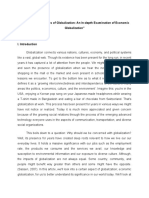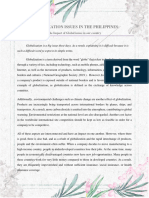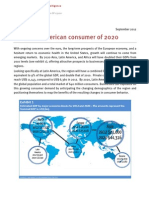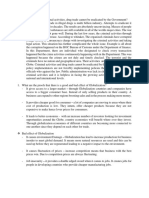Globalization and Consumerism
Globalization and Consumerism
Uploaded by
Piko WongCopyright:
Available Formats
Globalization and Consumerism
Globalization and Consumerism
Uploaded by
Piko WongCopyright
Available Formats
Share this document
Did you find this document useful?
Is this content inappropriate?
Copyright:
Available Formats
Globalization and Consumerism
Globalization and Consumerism
Uploaded by
Piko WongCopyright:
Available Formats
I shop therefore I am?
Globalization and Consumerism
If one needs to count what he or she has bought during the whole day before going to bed, it is probably an effective way to hypnotize one into dreams, because the list never seems to end. Our society has transformed into a community of consumers rather than citizens and consumerism can in fact be one of the most appropriate words to describe the globe. We spend more than what we need, we spend to make ourselves feel better and the worst part is we spend to prove that we are actually living and a part of the group. This act, defined as consumerism here, can be largely attributed to the trends rising from globalization. Throughout this paper, globalization would mean various trends resulting from the increasing connections and interdependence between
countries, including developed and developing ones. In this paper, I try to prove the hypothesis that globalization and consumerism form a cycle between them.
How does Globalization lead to Consumerism?
Mass production would be a major factor contributing to consumerism. Some economists even pointed out that the consumer society is in fact the result of mass production. In contemporary economics, mass production no longer means producing the same product of same color and size but products of same function with some varieties, these varieties could however turn basic good into luxuries. Even today, consumers do not need much variation to value more on goods. Globalization leads to specialization at national level as it is much more efficient for countries to exploit its own comparative advantages. Mass production would certainly lower the costs of the goods that are previously exclusive to the affluent due to the high prices. Therefore,
now what was previously considered elite consumption has become mass consumption and such phenomenon plays a major role in consumerism. In fact, when comparing the expenditure pattern of an average US household in 1984 with that in 20091, we can see that while the total expenditure has increased for 210%, money spent on entertainment has surged by 242%; we can see how people are using more of their money on extras rather than the basics. Even though mass production leads to lower price of goods through economies of scale and scope, consumers as a whole still have to spend more on them.
Advertising, a fast growing industry under globalization, is one of the major factor that turns citizens into shopaholic. Companies are spending millions on advertising and signing contracts with celebrities as spokepersons. During 2009 and 2010, it is extimated that the world has spent $1563bn on advertising, around 3% of the worlds
1 Consumer Expenditure Survey, Bureau of Labor Statistics, United States Department of Labor
total GDP2. Every moment, we are bombarded by posters, sound clip and animation that tell you how beautiful your life would become after consuming these products. The emergence of online marketing makes advertising in commonplace. The message that most of the advertisements carry is how your look and body-shape can be improved. They benchmark the way that beauty is defined and make us feel inferior for failing to fit with that definition. We consume so as to be consumed. Companies, instead of informing customers through ads, aim to make use of the asymmetric information by inducing customers to think that it is not up to them to choose, it is a must. Although the effect of advertising on sales is hard to quantify, we could still see a positive relationship between them. Moreover, the costs of advertising are shifted to the consumers through raising the prices. Therefore, advertising would lead to an increase in both the quantity and price of products.
2 Advertising & Branding Industry Overview, Plunkett Research
The rapid technological advancement and spread under globalization in fact makes the act of shopping so easy that we do not feel we have spent that much by inventing the Shopping Twins, namely Automated Teller Machine (ATM) and credit cards. Psychologically, consumers tend to spend more when they do not see the money physically as in the case of credit cards and by the same sense, they do not feel that their savings are disappearing when they withdraw money from their bank accounts. Such trend is accelerated by electronic money such as Oyster Card and Octopus Card. All these make bank notes and coins unnecessary when making payments on our new bags and clothes. In fact, since the introduction of general-purpose credit card in 1966, consumption as a percentage of GDP increased for more than 10% in US3. There was once a Visa Card slogan as Could be cheap. Could be expensive. Visa. All you need. It witnessed how widely used are the credit cards nowadays when there were more than 350million4 transactions of less than USD5 alone in United States
3 Final consumption expenditure, etc. (% of GDP), The World Bank 4 Credit Card Debt and Consumption: Evidence from Household-Level Data, Tufan Ekici &
Lucia Dunn
back in 2004. From 1980 to 2009, the amount of debt increased from $355billion to $2.5trillion5. Credit card debt alone takes up 21.5% of the total debt that the US population carries.
How does Consumerism further drive Globalization?
The relationship between globalization and consumerism is in fact a two-way one and consumerism further enforces the trend of globalization in various ways. Mass consumption cannot be achieved without mass production which requires high productivity and therefore specialization on national level. This makes each country relies on others to provide it different types of goods and this further increases the links between countries. This interdependence can be seen from the import ratios, value of imports to the value of GDP as a whole. By 2005, we can see that the
5 Consumer Credit, Federal Reserve Credit Release November 2010
weighted average import ratios for the top 164 countries is 48.6% while six countries have a ratio exceeding 100%6 (Appendix 1). These economies such as Singapore are highly specialized and small and need to rely on other countries to satisfy most of its necessities. Because of such a significant interdependence between countries, crisis or downturns in one country will lead to chain. This is the reason why the leading economies would have meetings and organizations between themselves as means for coordinating economic strategies, such as G20 Submit and Organization for Economic Cooperation and Development (OECD). They have to make sure that their economies will not be severely affected but in fact agreements and commitments are hard to achieve when leaders have incentives to cheat in order to gain a larger slice.
Such increasing interdependence in fact further enforces globalization by tempting countries to open up their economies in the hope of raising the living standards of
6 Imports of goods and services as % of GDP (most recent) by country, NationMasters
their people. China, as a communist economy, is a lively example to show the attempt to open up the economy. This makes her people to increase consumption of foreign goods and be closer to the global community. China joined World Trade Organization (WTO) in 2001, with foreign trade valued at RMB 3927bn7 and by August 2010, trade has already increased 313% to RMB 12302bn while imports alone have increased by almost 187% from 2001 to 20108. There is the increasing consumption of foreign goods by Chinese consumers. According to the National Bureau of Statistics of China, the average number of mobile phones owned by each 100 households increased from 19.5 in 2001 to 172 in 20099, an 883% rise (Appendix 2). Ownership of other consumer goods such as automobiles and color televisions also increased. We can see that the increasing domestic demand for more and better goods together with the foreign demand for Chinas food and manufactured products urged the world and China to jointly decide the opening of this giants door. Such move has
7 Total Value of Imports and Exports 2001, National Bureau of Statistics of China 8 Brief Statistics on China's Import & Export (2010/08), Ministry of Commerce, PRC 9 Number of Major Durable Consumer Goods Owned Per 100 Urban Households at the Yearend, 2001&2009, National Bureau of Statistics of China
not only affected the economic side but also the cultural side. Western cultures, especially the American ones have now been generally accepted in China. The line between West and East is now more indistinguishable than it was.
Consumerism enables everything to be exported and imported, including cultures and festivals. Marketing people are motivated to find reasons for consumers to spend while we are also willing to have new occasions that justify crazier shopping, regardless the origins. Export of festivals is an easy way of achieving this purpose. It is common to see Western festivals such as Christmas, Valentines Day and Mothers Day exported to Asian cities and justified ridiculous price increases. According to surveys done in China, over 60% of respondents responded that Christmas is a way for them to their love to significant others while 35% of them regarded Christmas as a day to relax10. More importantly, most of the students did not know that Jesus Christ
10 Chinese Spend Christmas Blindly, Liu Fang, Global Times
was the origin of this festival and some of them even thought that Santa Claus was the origin. This proves the selective import of festivals by countries. Consumerism leads to more connection between countries when they share same festive seasons, although what is really exported is only the feature of spending rather than the actual religious or cultural meaning. Such export of celebrations is supported by the fact that 169 out of 193 countries (87.56%) make Christmas Day a national holiday while only 114 countries (59.07%)11 have a majority of population as Christians.
Economic Implications
Consumerism leads to significantly increase in both domestic and foreign demand for goods and theoretically, it would lead to increase in income and is definitely good for economy. However, this is only true in the short run. In the long run, when people
11 Christianity by country, Wikipedia
10
spend all of their income on consumption and save basically nothing, the economy would have nothing to support its development. United States proved the disastrous effects of consumerism. With a constantly dropping saving rate and increasing debt level from 1980 to 2008, the States is unable to use its peoples own money to pay for its own investment and development and therefore has a low GDP growth rate less than 3% per year during that period of time 12(Appendix 3). The increasing issue of the government bonds is aimed at attracting foreign capital to finance the development. The Global Financial Crisis 2008 did not only reveal the wrongdoings of the investment banks, it also reminded the Americans of how they have spent recklessly and unnecessarily for the past few decades. Their consumption pattern and credit card debts have made them realize the importance of saving and resulted in a significant increase in the national saving rate of the US. Consumerism changes the
12 United States GDP Growth Rate, World Bank
11
composition of a countrys GDP which would lead to a drop in capital accumulation and therefore erosion of growth potential in the long run.
Furthermore, we can also see that consumerism is reducing the effectiveness of economic policies of any particular country alone. As mentioned earlier, there is an increasing interdependence between countries resulted from international trade and openness of economy. In the past, when trade is not that significant for a country, she could use either fiscal or monetary policies to achieve the desired output level, interest rate and even unemployment rate. However, this is not the story of today. The emergence of economic organizations and regular meetings between countries are in fact restraining the ability of countries to implement their own economic policies and the results are likely to affect their trading partners as well. Also, when there is economic downturn in a lot of countries, such interdependence between them is likely
12
to make the situation worse instead of the other way round. We can foresee that recession would lead to reduce in imports, which is equivalent to reduction in export of another country which would then suffer further reduction in income. Therefore, while the increased degree of globalization can foster the interactions between countries, it would also result in worse scenarios when things go bad. Due to the financial crisis, US experienced almost a quarter of reduction imports and such reduction has great impact on Japan, Mexico, China and Canada as they are the top suppliers to US13. (Appendix 4) China has suffered a $229bn loss in exports and 18% of the reduction has come from US14. While these countries already suffered from the financial crisis, the reduction in import income makes things worse and formed a chain effects that cannot be controlled by unilateral policies.
13 U.S. Trade Overview, International Trade Administration, Oct 2010 14 US-China Trade Statistics and China's World Trade Statistics, US-China Business Council 13
Finally, the relationship between consumerism and globalization and the resulting openness lead to curtailed competitiveness of small businesses. As the foreign demand for unique domestic products increase, it is very likely that big businesses or chain stores would be the first ones to export their products to satisfy the foreign demand instead of the small ones. Therefore, the first exporters could gain the first mover advantages together with a strong foothold in foreign markets which could enable it to capture market power that is great enough for them to drive out future entrants. They are also likely to swipe out the existing businesses in towns as well because it has been shown that people are more confident in chain stores when they know equally little in both. We can see that although McDonalds is market leader in many countries, KFC is in fact able to outperform it by acting as first-mover. When a giant failed to compete, small businesses are likely to have a high failure rate and can only continue business with small market share. This trend is harmful for the industry
14
development as it limits the competition and reduces the choices available for consumers. By now, (Multinational Corporations) have taken up over 70% of worldwide trade while developing countries lose $2bn per day because of unjust trade rules15.
Ending remarks
Throughout this paper, I have tried to explain how consumerism and globalization interact with each other. We can see that this is in fact a cycle in which one would enforce the other and vice versa. Nevertheless, I believe that this is a pessimistic phenomenon because consumerism in fact replaces the cultural values of a society which has built up the shape of that particular country. With consumerism comes emptiness as we can see that countries where consumerism is prevalent no longer have their own distinctive values and traditions in the same way that they had 20
15 Trade liberalisation statistics, World Trade Organization
15
years ago. Consumption is a natural act as we need to purchase necessities with our income. However, does it mean that we need to have a new mobile phone every year and new bags every season? Economy cannot be sustained without peoples consumption, yet economy may collapse with over-consumption and incredibly low saving rates. Consumerism has huge impact on globalization as the products consumed today come from everywhere in the world and this would lead to a more connected but restrained world economy. With the trend of increasing specialization at national level, further reduction in national control of economy is expected.
16
References
United States Department of Labor, (2009) Consumer Expenditure Survey, http://www.bls.gov/cex/, November 24 2010
Plunkett Research, (2010) Advertising & Branding Industry Overview, http://www.plunkettresearch.com/Industries/AdvertisingandBranding/Advertisin gandBrandingStatistics/tabid/70/Default.aspx , November 24 2010
The World Bank, (2009) Final consumption expenditure, etc. (% of GDP), http://data.worldbank.org/indicator/NE.CON.TETC.ZS, December 5 2010
Tufan Ekici & Lucia Dunn (2006). Credit Card Debt and Consumption: Evidence from Household-Level Data. Instructor and Professor Thesis, Middle Eastern Technical University and Ohio State University.
Federal Reserve Statistical Release, (November 5 2010) Consumer Credit, http://www.federalreserve.gov/releases/g19/Current/, November 24 2010
17
NationMasters, (2009) Imports of goods and services as % of GDP (most recent) by country, http://www.nationmaster.com/graph/eco_imp_of_goo_and_ser_as_of_gdp -economy-imports-%0bgoods-services-gdp#source, November 24 2010
National Bureau of Statistics of China, (2002) Total Value of Imports and Exports 2001, http://www.stats.gov.cn/english/statisticaldata/yearlydata/YB2001e/ml/ indexE.html, November 29 2010
Ministry of Commerce, PRC, (October 12 2010) Brief Statistics on China's Import & Export (2010/08), http://english.mofcom.gov.cn/aarticle/statistic/BriefStatistics/ 201010/0101007180368.html, November 29 2010
National Bureau of Statistics of China, (2001 & 2009) Number of Major Durable Consumer Goods Owned Per 100 Urban Households at the Year-end, http://www.stats.gov.cn/tjsj/ndsj/2009/html/J0910e.htm, November 29 2010
Paul Ransome. (2005), Work, Consumption & Culture, London: Sage Publications.
18
Liu Fang, (December 24 2006) Chinese Spend Christmas Blindly, http://world.people.com.cn/BIG5/57506/5205752.html, November 29 2010
Wikipedia, (2009) Christianity by Country, http://en.wikipedia.org/wiki/Christianity_by_country, November 29 2010
World Bank, (Feb 2010) United States GDP Growth Rate, http://data.worldbank.org/indicator/NY.GDP.MKTP.KD.ZG, December 3 2010
International Trade Administration, (Oct 2010) U.S. Trade Overview, http://www.trade.gov/mas/ian/build/groups/public/@tg_ian/ documents/webcontent/tg_ian_003095.pdf , December 3 2010
US-China Business Council, (2010) US-China Trade Statistics and China's World Trade Statistics, http://www.uschina.org/statistics/tradetable.html , December 3 2010
Emily Starbuck Gerson and Ben Woolsey, (May 11 2009) Credit Card.com, http://www.creditcards.com/credit-card-news/credit-cards-history-1264.php, December 5 2010
19
World Trade Organization, (2000) Trade liberalisation statistics, http://www.gatt.org/trastat_e.html, December 5 2010
20
Appendix 1 Imports of goods and services as % of GDP (most recent) by country
Rank
Countries
Amount
# 1 Equatorial Guinea:
173.48
# 2 Singapore:
151.84
# 3 Luxembourg:
134.85
# 4 Seychelles:
113.49
# 5 Guyana:
111.25
# 6 Puerto Rico:
100.44
21
# 7 Malaysia:
97.96
# 8 Estonia:
94.39
# 9 Malta:
92.28
# 10 Sao Tome and Principe:
86.08
# 11 Lesotho:
85.55
# 12 Suriname:
85.17
# 13 Slovakia:
82.48
# 14 Samoa:
81.71
# 15 Swaziland:
81.19
22
# 16 Belgium:
81.09
# 17 Palau:
80.93
# 18 Nicaragua:
80.51
# 19 Ireland:
80.49
# 20 Mongolia:
79.96
# 21 Antigua and Barbuda:
79.34
# 22 Eritrea:
75.94
# 23 Tajikistan:
75.89
# 24 Maldives:
75.77
23
# 25 Moldova:
74.42
# 26 Belize:
74.11
# 27 Czech Republic:
73.79
# 28 Guinea-Bissau:
73.63
# 29 Saint Kitts and Nevis:
72.94
# 30 Marshall Islands:
72.69
# 31 Gambia, The:
71.46
# 32 Belarus:
71.39
# 33 Ghana:
70.48
24
# 34 Grenada:
70.1
# 35 Jordan:
69.02
# 36 Namibia:
66.21
# 37 Dominica:
63.82
# 38 Bulgaria:
63.18
# 39 Fiji:
62.85
# 40 Mauritius:
62.83
# 41 Djibouti:
62.8
# 42 Slovenia:
62.68
25
# 43 Hungary:
62.61
# 44 Saint Vincent and the Grenadines:
62.31
# 45 Angola:
62.26
# 46 Cambodia:
61.32
# 47 Saint Lucia:
61.21
# 48 Thailand:
60.2
# 49 Bhutan:
59.86
# 50 Netherlands:
59.73
# 51 Bahrain:
59.16
26
# 52 Cape Verde:
57.09
# 53 Vietnam:
56.76
# 54 Macedonia, The Former Yugoslav Republic of:
55.89
# 55 Lithuania:
55.85
# 56 Jamaica:
55.81
# 57 Honduras:
54.99
# 58 Ukraine:
54.47
# 59 Latvia:
54.19
# 60 Bosnia and Herzegovina:
53.85
27
# 61 Chad:
52.79
# 62 Croatia:
52.77
# 63 Austria:
52.58
# 64 Barbados:
52.49
# 65 Tunisia:
51.61
# 66 Mauritania:
50.71
# 67 Togo:
49.75
# 68 Nigeria:
48.96
# 69 Kazakhstan:
48.68
28
# 70 Cyprus:
48.32
# 71 Philippines:
47.43
# 72 Turkmenistan:
47.09
# 73 Israel:
46.94
# 74 Armenia:
45.95
# 75 Costa Rica:
44.93
# 76 Mozambique:
44.03
# 77 Sri Lanka:
43.66
# 78 Papua New Guinea:
43.45
29
# 79 Trinidad and Tobago:
42.96
# 80 El Salvador:
42.88
# 81 Mali:
42.29
# 82 Lebanon:
42.08
# 83 Albania:
41.66
# 84 Romania:
41.62
# 85 Portugal:
41.24
# 86 Switzerland:
41.13
# 87 Iceland:
40.95
30
# 88 Gabon:
40.65
# 89 Sweden:
40.56
# 90 Denmark:
39.18
# 91 Canada:
38.64
# 92 Paraguay:
38.23
= 93 Azerbaijan:
38.14
= 93 Georgia:
38.14
# 95 Malawi:
37.96
# 96 Senegal:
37.61
31
# 97 Kuwait:
37.41
# 98 Zambia:
37.32
# 99 Sierra Leone:
37.29
# 100 Kyrgyzstan:
36.68
# 101 Qatar:
35.87
# 102 Morocco:
35.71
# 103 New Zealand:
35.08
# 104 Panama:
34.87
# 105 Botswana:
34.67
32
# 106 Kenya:
34.57
# 107 Ecuador:
34.19
# 108 Haiti:
33.36
# 109 Germany:
33.07
# 110 Poland:
33.01
# 111 New Caledonia:
32.99
# 112 Greece:
32.93
# 113 Chile:
32.66
# 114 Indonesia:
32.58
33
# 115 Cote d'Ivoire:
32.29
# 116 Dominican Republic:
32.06
# 117 Nepal:
32.03
# 118 Madagascar:
31.75
# 119 Finland:
31.58
# 120 Spain:
31.4
# 121 Ethiopia:
31.21
# 122 Turkey:
31.04
# 123 Syria:
30.75
34
# 124 Norway:
30.45
# 125 Mexico:
29.97
# 126 Guinea:
29.45
# 127 United Kingdom:
29.28
# 128 Cameroon:
29.17
# 129 Comoros:
29
=130 Uzbekistan:
27.97
=130 Guatemala:
27.97
# 132 Benin:
27.9
35
# 133 Italy:
26.67
# 134 France:
26.35
# 135 Burkina Faso:
25.86
# 136 Rwanda:
25.83
# 137 Uganda:
25.62
# 138 South Africa:
25.29
# 139 Niger:
24.88
# 140 Bolivia:
24.49
# 141 Saudi Arabia:
24.45
36
# 142 Tanzania:
24.33
# 143 French Polynesia:
24.23
# 144 Russia:
24.15
# 145 China:
23.41
# 146 Australia:
22.75
# 147 Bangladesh:
22.32
# 148 Algeria:
21.4
# 149 Zimbabwe:
20.67
# 150 Uruguay:
19.89
37
# 151 Pakistan:
19.35
# 152 Colombia:
19.04
# 153 Burundi:
18.22
# 154 Cuba:
18.17
# 155 Peru:
17.28
# 156 Sudan:
16.15
# 157 Libya:
15.46
# 158 India:
15.43
# 159 United States:
14.95
38
# 160 Central African Republic:
14.92
# 161 Brazil:
14.4
# 162 Argentina:
10.16
# 163 Japan:
9.81
# 164 Burma:
1.05
Weighted average:
48.6
Source: Imports of goods and services as % of GDP (most recent) by country, Nations Master
39
Appendix 3 GDP Growth Rates of United States
GD Growth R of United S P ate tatesfrom1960 to 2010
8
)4 % ( e t a R2 h t w o r G0
1950 -2 1960 1970 1980 1990 2000 2010 2020
-4
Y ear
GDP Growth % Linear (GDP Growth % )
Source: United States GDP Growth Rate, The World Bank
40
You might also like
- Introduction To Globalization-Contemporary WorldDocument29 pagesIntroduction To Globalization-Contemporary WorldBRILIAN TOMAS75% (4)
- Thieu Nang - Session 3 - Linear Development Assignment SheetDocument2 pagesThieu Nang - Session 3 - Linear Development Assignment SheetTrang MsNo ratings yet
- Ias 16Document3 pagesIas 16Jhonalyn ZonioNo ratings yet
- Deloitte Reports - Consumer 2020Document28 pagesDeloitte Reports - Consumer 2020huhataNo ratings yet
- Bahasa EnggressssDocument10 pagesBahasa EnggresssshanifkhoirudinNo ratings yet
- World Footwear Consumer 2030Document48 pagesWorld Footwear Consumer 2030Elzy100% (1)
- US Retail Trends Spending MillennialsDocument3 pagesUS Retail Trends Spending MillennialsAnna KruglovaNo ratings yet
- Financial Dependence: The Other Side of GlobalisationDocument6 pagesFinancial Dependence: The Other Side of GlobalisationChristian CopeNo ratings yet
- Global Issues and Challenges Towards A More Sustainable WorldDocument28 pagesGlobal Issues and Challenges Towards A More Sustainable WorldHarry DecilloNo ratings yet
- Globalization PDFDocument20 pagesGlobalization PDFGeorge Villadolid100% (3)
- Freedom of Association Civil SocietyDocument10 pagesFreedom of Association Civil SocietyrajendrakumarNo ratings yet
- Over The Last 30 Years, There Has Been A Shift Away From A World in Which National EconomiesDocument7 pagesOver The Last 30 Years, There Has Been A Shift Away From A World in Which National EconomiesAhmed HonestNo ratings yet
- Ge3 Finalrequirement Group3Document11 pagesGe3 Finalrequirement Group3Ina Gabrielle AnclaNo ratings yet
- PeachesDocument16 pagesPeacheshatdogaeronNo ratings yet
- Why Globalization Is Going Nowhere Despite The Current PanicDocument3 pagesWhy Globalization Is Going Nowhere Despite The Current PanicIoana DiaconescuNo ratings yet
- 2011 Chinese Consumer Report EnglishDocument48 pages2011 Chinese Consumer Report EnglishFeiNo ratings yet
- Central Banks and Globalization 1Document4 pagesCentral Banks and Globalization 1RonJen VlogsNo ratings yet
- International Trade and Business Has Shaped The Modern Societal Structure As We Know It TodayDocument8 pagesInternational Trade and Business Has Shaped The Modern Societal Structure As We Know It Todaymikebell117No ratings yet
- For PortfolioDocument8 pagesFor PortfolioJerwil AniganNo ratings yet
- Aid For ETrade Accelerating The Global ECommerce Revolution - SuominenDocument27 pagesAid For ETrade Accelerating The Global ECommerce Revolution - SuominenLeonardo AguilarNo ratings yet
- Consumer Buying Behavior-USADocument5 pagesConsumer Buying Behavior-USAshrutichandokeNo ratings yet
- Lebanon Group EthicsDocument6 pagesLebanon Group EthicsKeni KennNo ratings yet
- Globalization Engelska 7Document3 pagesGlobalization Engelska 7Nigar AlijevaNo ratings yet
- Beyond GDPDocument11 pagesBeyond GDPalearmesNo ratings yet
- How Should We Measure The Digital Economy?Document7 pagesHow Should We Measure The Digital Economy?Djura chvorovicNo ratings yet
- Moncenilla, A.D, M.Document4 pagesMoncenilla, A.D, M.Ayna Denisse MoncenillaNo ratings yet
- Mckinsey Meet The 2020 ConsumerDocument44 pagesMckinsey Meet The 2020 ConsumerChinmay JhaveriNo ratings yet
- Individual ReportDocument5 pagesIndividual ReportkaylovelluNo ratings yet
- The Tiger Roars PDFDocument23 pagesThe Tiger Roars PDFRitish AdhikariNo ratings yet
- Economic Growth: Interest RateDocument4 pagesEconomic Growth: Interest RateShruti JhunjhunwalaNo ratings yet
- Consumer Behavior - 10 Global Consumer Trends in 2011: by Dominic Harrison, Future FoundationDocument4 pagesConsumer Behavior - 10 Global Consumer Trends in 2011: by Dominic Harrison, Future FoundationvijayareshmiiNo ratings yet
- Thesis GlobalizationDocument7 pagesThesis Globalizationfbyx8sck100% (1)
- Demographic Transformation Worldwide - 072011Document13 pagesDemographic Transformation Worldwide - 072011Jaime MelendezNo ratings yet
- Croitoru Adrian-Marian Rise An Ii The Challenge of GlobalisationDocument3 pagesCroitoru Adrian-Marian Rise An Ii The Challenge of Globalisationflory82floryNo ratings yet
- Inflation: Price, The Amount of Money That Has To Be Paid To Acquire A Given ProductDocument11 pagesInflation: Price, The Amount of Money That Has To Be Paid To Acquire A Given ProductAnonymous fkQOAe2RNo ratings yet
- Articles: 1) Trump's China Decoupling' and Coronavirus: Why 2020 Upheaval Won't Kill GlobalisationDocument13 pagesArticles: 1) Trump's China Decoupling' and Coronavirus: Why 2020 Upheaval Won't Kill GlobalisationRahul PambharNo ratings yet
- Effects On ConsumerismDocument19 pagesEffects On ConsumerismNara GarridoNo ratings yet
- INTL 101 - GlobalizationDocument27 pagesINTL 101 - Globalizationirs_ijs190% (1)
- Article - LatAm Consumer 2020 - 20120904Document6 pagesArticle - LatAm Consumer 2020 - 20120904Aldo FinettiNo ratings yet
- GlobalizationDocument8 pagesGlobalizationishwarmayumNo ratings yet
- BBS 1st Year Globalization ChapterDocument9 pagesBBS 1st Year Globalization ChaptergaurabNo ratings yet
- Globalization: Assignment Submitted byDocument10 pagesGlobalization: Assignment Submitted byahsanNo ratings yet
- Make Money Importing From ChinaDocument22 pagesMake Money Importing From Chinaiansmith1100% (1)
- Globalization and CSRDocument25 pagesGlobalization and CSRAmbreen ZainebNo ratings yet
- Research Paper by 2Document7 pagesResearch Paper by 2kaylovelluNo ratings yet
- Consumer Online Buying Behavior ActivityDocument4 pagesConsumer Online Buying Behavior ActivityEugene E. RegaladoNo ratings yet
- Short Presentation About Globalization and Its Impact On Economic GrowthDocument3 pagesShort Presentation About Globalization and Its Impact On Economic GrowthDonata KetlerytėNo ratings yet
- Why Do You Think Criminal ActivitiesDocument4 pagesWhy Do You Think Criminal ActivitiesjhanelleNo ratings yet
- Tugas EconDocument8 pagesTugas EconJeremy HooNo ratings yet
- Retail Sector in ChinaDocument15 pagesRetail Sector in ChinaSurya NarayananNo ratings yet
- Entry 4 - Eco Jam 3Document1 pageEntry 4 - Eco Jam 3brithalynsoNo ratings yet
- A Final Assessment of 2000 Words Essay in The Subject "'Economics, Taxation, Reform Cooperation and Entrepreneurship (ECO221) "Document6 pagesA Final Assessment of 2000 Words Essay in The Subject "'Economics, Taxation, Reform Cooperation and Entrepreneurship (ECO221) "Trisha Lyn SeeNo ratings yet
- Global Dimensions of International Business - Term III AssignmentDocument5 pagesGlobal Dimensions of International Business - Term III AssignmentAnanya RoyNo ratings yet
- Thesis On Economic Growth and Income InequalityDocument8 pagesThesis On Economic Growth and Income Inequalitysheilaguyfargo100% (2)
- The Global EconomyDocument3 pagesThe Global Economymaryrose.vdelossantosNo ratings yet
- Classifying World EconomiesDocument13 pagesClassifying World Economiesngan nguyenNo ratings yet
- Global EconomyDocument14 pagesGlobal EconomyMustaffa MansoorNo ratings yet
- Global Baby Burst Marketing AssignmentDocument5 pagesGlobal Baby Burst Marketing AssignmentVarun SharmaNo ratings yet
- My perspective on GlobalizationDocument3 pagesMy perspective on Globalizationaliyah.bulagner06No ratings yet
- Bisnis InternasionalDocument10 pagesBisnis InternasionalFAS ANo ratings yet
- Ec102 Microeconomics SyllabusDocument5 pagesEc102 Microeconomics SyllabusclimpiasparadaNo ratings yet
- Portfolio BalanceDocument43 pagesPortfolio BalanceBeyond TutoringNo ratings yet
- Market Days & Support and ResistanceDocument41 pagesMarket Days & Support and ResistanceBlue BirdNo ratings yet
- Econ Dev Chapter 5Document6 pagesEcon Dev Chapter 5Feizhen Mae RodelasNo ratings yet
- Project Analysis - Financial & EconomicalDocument28 pagesProject Analysis - Financial & EconomicalHarita SalviNo ratings yet
- QUIZ 3 Global Trade For StudentsDocument5 pagesQUIZ 3 Global Trade For StudentsLyka M. Manaloto100% (1)
- Course Matrl-1 - SCM - F Sem 2017-18Document31 pagesCourse Matrl-1 - SCM - F Sem 2017-18Pulkit JainNo ratings yet
- Venture CapitalDocument23 pagesVenture CapitalRatnesh SinghNo ratings yet
- Money, Banking and Financial Markets ContentDocument10 pagesMoney, Banking and Financial Markets ContentSana nadeem0% (1)
- Knowledge EconomyDocument28 pagesKnowledge EconomyRodrigo Sánchez MariñoNo ratings yet
- Some New Evidence On Why Companies Use Convertible BondsDocument12 pagesSome New Evidence On Why Companies Use Convertible BondsferinadNo ratings yet
- BBA II Chapter 3 Depreciation ProblemsDocument4 pagesBBA II Chapter 3 Depreciation ProblemsSiddharth SalgaonkarNo ratings yet
- Aggregate Supply & Aggregate Demand: Questions To Be AnsweredDocument12 pagesAggregate Supply & Aggregate Demand: Questions To Be AnswereditvmerivelesNo ratings yet
- Ownership Structure, Corporate Governance and Firm Performance (#352663) - 363593Document10 pagesOwnership Structure, Corporate Governance and Firm Performance (#352663) - 363593mrzia996No ratings yet
- Net Eco SyllabusDocument10 pagesNet Eco SyllabusGopalNo ratings yet
- Franklin India Multi Cap Fund NFO LeafletDocument2 pagesFranklin India Multi Cap Fund NFO Leafletrajani.patil09No ratings yet
- Determinants of Budget Deficit in EthiopiaDocument28 pagesDeterminants of Budget Deficit in EthiopiaMulugeta DebelaNo ratings yet
- Chapter 3Document3 pagesChapter 3bohlale.mosalaNo ratings yet
- Dell Selling Directly GloballyDocument12 pagesDell Selling Directly GloballyPromity Rahman100% (3)
- 4EC0 01 Que 20130124Document24 pages4EC0 01 Que 20130124WandaNo ratings yet
- Debt CrisisDocument2 pagesDebt CrisisAmit DwivediNo ratings yet
- MonopolyDocument6 pagesMonopolyRian RianNo ratings yet
- Characteristics and Functions of MoneyDocument2 pagesCharacteristics and Functions of Moneyanastasiasteele_greyNo ratings yet
- Derivatives and Risk ManagementDocument82 pagesDerivatives and Risk ManagementRussel0% (1)
- Micro Eco, Ch-6Document20 pagesMicro Eco, Ch-6Umma Tanila RemaNo ratings yet
- Rational OptimistDocument6 pagesRational OptimistSonja StojakovićNo ratings yet
- Universiti Teknologi Mara Final Examination: Confidential BM/JAN 201 2/ECOI 62/104Document11 pagesUniversiti Teknologi Mara Final Examination: Confidential BM/JAN 201 2/ECOI 62/104Mark Victor Valerian IINo ratings yet

























































































